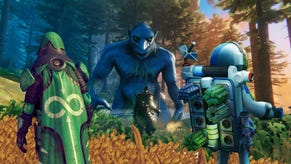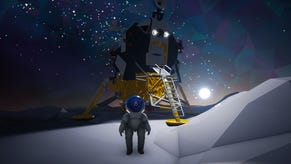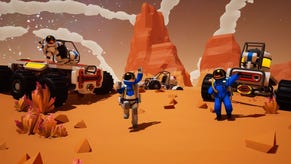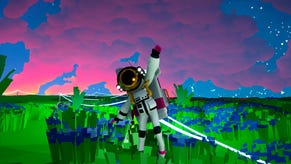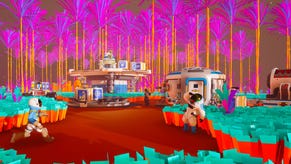How Astroneer makes crafting fun
“Content doesn’t stand in the way of content.”
This is The Mechanic, where Alex Wiltshire invites developers to discuss the inner workings of their games. This time, Astroneer [official site].
Astroneer is a space game about hoovering up alien materials with a magic gun and listening to them plop into your backpack. And in this Astroneer has cracked something very special in crafting and resource management: it’s actually fun.
Developer System Era Software has put a peculiar focus on how resources are presented and how you manipulate them, and at its centre is an idea that’s surprisingly rare in games:
THE MECHANIC: Resources are physical
Of course, Minecraft’s crafting system is kind of physical, in that its recipes ask you to place resources in a representation of the thing you’re making. But, locked into a menu, it’s an abstraction from the game world. That’s where Astroneer does things very differently. In fact, I haven’t played with a crafting system that’s as deeply implanted in its game world.
“This sounds a little too intentional, as if I had a masterplan, which I totally didn’t,” Jacob Liechty admits to me. “I had no idea what I was doing.”
It’s not even as if Liechty was a designer when he began to lead Astroneer’s design. He co-founded System Era having been a graphics engineer at Halo developer 343 Industries, and, knowing the project needed someone to concentrate on design, he took on the role with a prototype already made. From that point, when the game was called Exo (“Which is a terrible name”), he began to feel out a different way forward.
The first thing the team worked on was the the backpack, which carries your items and displays your power and oxygen supplies, and on which are mounted your upgrades. When you select it with E, it smoothly moves from your character’s back and towards you so you can start to interact with it with your mouse. “It’s the dumbest thing that the backpack flies up into your face,” says Liechty with a laugh. “It felt really dumb in the beginning, like why is it floating in front of your face? Who’s holding it? Narratively it makes zero sense. But you get used to it, and it works great.”
That’s because the backpack holds the key to that physicality. You drag items from slot to slot, items which you can see in the backpack when you’re running around, too. And as you gather resources with the game’s deformation tool, a kind of gun which can shape terrain as well as suck up resources, you can see them collecting into a stack which then moves into an open slot in the backpack when it’s filled.
System Era considered this process, something most other games represent with a number going up on a hotbar, incredibly closely. “We were being finicky about how we thought it should work. We were considering a rail from the deform tool to the backpack and shuffled around these mechanics until they slotted into their appropriate places.”
They give you a tactile sense of involvement with the crafting system, and the idea that your resources are identifiable physical objects carries through to all aspects of managing them. To craft larger objects, such as the smelter, you’ll see holograms and names of the resources where you need to place them. “When you go find that resource in the world and you see the same icon and text, you know it’s supposed to go there. It’s what it wants. It can tell you that without a textbox to say you have to put copper there, just because we maintain that consistency across the whole board. Honestly, it’s sort of a new - I can’t really point to another game. Well, if I could point to it, I’d have copied it.”
The overriding feel to Astroneer’s crafting system is of simplicity. Currently, there are only 13 different resources, and no crafting recipe requires more than one type, and the maximum number recipes demand is two units. This is heavily influenced by the physical nature of placing resources on their holograms: there simply isn’t room on most platforms’ 3D models to present more, though Liechty has ideas for how they can be extended.
This gives a novel clarity to Astroneer’s crafting system. It doesn’t need to tutorialise it, making your first play a self-driven exploration of both your world and the system, which is neither obtuse nor hand-holdy. And the decision to craft an item doesn’t carry the weight it does in most other crafting games, where it’s all too common to agonise over using a resource for one item instead of another. In Astroneer, at least in the early game, you tend to just try it out to see what results.
It also gave System Era, who brought Astroneer to Early Access with just six people, the ability to give a great deal of attention to each resource. “Let’s say we have 50 resources,” says Liechty. “There’s no way we’d go and make individual 3D models for them. It’d take forever. And some of the resources make different sounds when you collect them. Having so few resources allows us to give tonnes of character to each one.” It forced them focus on the important stuff. “If you have this massively complex [crafting system] and all these spreadsheets, you should give the time to focus on the core experience. I’ve always hammered home that it’s far more important to make a great core experience than an OK sprawling one.”
It’s lead to a remarkably generous crafting system. Tethers are an important item which you implant in the ground to carry conduits of oxygen out into the world so you can travel further before your suit’s supplies run out. You’ll use many of them as your web of tethers grows, and you get 11 of them for each unit of compound, which is a common resource. Contrast this with Minecraft’s torches, which perform a similar role. To make a batch of four torches, you need a stick (crafted from two planks, which in turn are crafted from wood chopped from trees) and a coal (mined from common but sporadic coal deposits), or charcoal (which is smelted from wood in a furnace).
Astroneer’s generosity is balanced against a constraint which feels frustrating in most crafting games. Your backpack can only carry eight items compared to, for example, the 36 slots in a Minecraft inventory, each of which can usually carry up to 64 of the same item.
Why doesn’t it feel frustrating? “That’s a hard question,” says Liechty. “I remember being concerned early on about the player’s backpack. I don’t know.” He laughs. “The boisterous or arrogant answer would be, you just gotta design better. If you decide your game needs to be such and such and it needs to have an inventory with 100 slots, then that’s your fault!”
But there’s a truth in that cod-arrogance. “If you decide a limited number of resource slots is important, it just becomes a new constraint. It influences everything else, like the recipes, which will be relative to how hard it is to get those resources back to your base. We try to decide how much things cost and how many tethers you get, and you just set the resources appropriately, make trade-offs, and make sure it’s balanced and eventually end up with something that works.”
So it’s down to balance, but there’s more to the backpack’s size. For one thing, Liechty suggests that its limitation means it’s easier to remember its contents, so it’s more present in your mind and feels less cluttered. But I also find going out for resources fun; when I run out of copper, it’s not such a chore to go gallivanting out to gather more.
The deformation tool is, after all, a lovely thing, plumply reforming the land, and the ploppy sounds as resources collect and transfer to your pack (designed by Riley Gravatt) are lovely. The whole process is satisfying, especially since you’ll have used your own network of tether-lines to get to the resource spot.
It highlights something about crafting systems which so many other games seem to miss. Running out of materials doesn’t have to simply be a blocker to the thing you want to get to. Liechty puts it like this: “Content doesn’t stand in the way of content.” He means that something in a game that’s stopping you from having or doing the thing you want, well, it’s still part of the game.
“I think people have this weird ontology about what a videogame is and where the actual fun is. They’ve forgotten that in videogames there’s no such thing as a trough of non-content. There’s not just one goal in a game which you’re just trudging through to get to. The whole game is a game.”
Astroneer shows that what can be boring in many games doesn’t have to be, and that constraints, both constraints on the player and constraints on the developer, can lead to wonderful things. Such as hoovering up alien materials with a magic gun.









